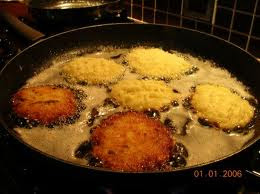I love plantains, especially green plantain, the type that we prepare in fritters called tostones. But you also have ripe plantains; essentially green plantains that have ripened to a deep, dark yellowish color. Some people prefer the ripe plantain since they give a sweeter flavor. In my family we prefer tostones. Although once in a while we cook ripe plantains with eggs for breakfast; or in a traditional dish called pinon (pronounced peen-yon) , a layered casserole of ripe plantains, beef and kidney beans.
Another of our favorite uses of ripe plantains is cheese-stuffed plantain balls. Think of it as fallafel balls but with cheese inside and a luscious, sweet exterior. Believe me, once you’ve had these plantain balls, you’ll be hooked. They can be served as an appetizer or as a main entree accompanied by rice—a perfect vegan dish.
CHEESE-STUFFED PLANTAIN BALLS
6 ripe plantains, unpeeled and cut in half widthwise
8 cups water
Salt to taste
1/4 cup butter
2 tablespoons cornstarch plus cornstarch for shaping balls
1/2 pound cheddar cheese, shredded
Oil for deep frying (vegetable oil, corn oil, canola oil, olive oil, etc.)
1. Drop the plantain halves into boiling salted water and cover. Cook rapidly for 20 minutes. Drain. Peel the plantains and mush the pulp. Add the butter and 2 tablespoons cornstarch and mix well. Let cool enough to handle.
2. To shape the balls, coat the palms of the hands with cornstarch. Pick up about 1 tablespoon of the pulp (or 1 teaspoon, depending on the size desired) and flatten slightly between the palms. Add a portion of the cheese and mold the plantain around it, shaping the whole into a ball. Repeat until all the balls are formed. Be aware that you can make the balls as large or as small as you desire. In the Rivera family we like big plantain balls. Other folk may prefer smaller variations similar to Swedish-type meatballs.
3. Heat the oil for deep frying. Drop the balls into the oil and cook until golden. Remove and drain on paper towels.
Yield: 8 to 12 balls, depending on size.





 Zemanta”>
Zemanta”>
![Reblog this post [with Zemanta]](http://img.zemanta.com/reblog_b.png?x-id=05dd829a-25c6-4c86-84be-049320f88105)

![Reblog this post [with Zemanta]](http://img.zemanta.com/reblog_e.png?x-id=47f4c005-b059-43b4-862a-30e6bd16aa73)